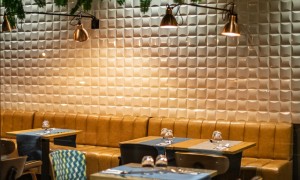In a locked room in a busy city, some terrorists are holding a hostage. The curtains are mostly drawn, cutting off any direct line of sight for those outside. In a building across the street, a team of engineers are set a task: they can have whatever equipment they need, but they must paint as clear a picture as possible of what is happening inside the room.
在一个繁忙的城市中的一间上了锁的房间里,一帮恐怖分子劫持了一名人质。窗帘被拉上了一大半,从外面无法直视其中。在街对面的一栋楼里,一队工程师接到了一项任务:他们可以拿到任何他们需要的设备,但必须尽可能清晰地描绘出房间内正在发生的事情。

This was the challenge given in 2015 to Daniele Faccio, then at Heriot-Watt University, in Edinburgh, by Dstl, a British government defence laboratory. He and his team eventually found a way to see around corners from a distance of 50 metres— which was reckoned impressive at the time, even though the system they devised could detect only the motion and position of hidden objects, rather than taking pictures of them. Now, however, Xu Feihu and Pan Jianwei of the University of Science and Technology of China, in Hefei, have blown that record out of the water. As they describe in the Proceedings of the National Academy of Sciences, they have managed to look around corners from a distance of well over a kilometre.
这是2015年英国政府的国防科技实验室Dstl给丹尼尔法乔(Daniele Faccio)的任务。当时供职于爱丁堡的赫瑞瓦特大学(Heriot-Watt-University)的法乔和他的团队最后找到了从50米开外隔墙观物的方法—这在当时被认为非常了不起,尽管他们设计的系统只能检测到隐藏物体的动作和位置而无法给它们拍照。然而现在,位于合肥的中国科学技术大学的徐飞虎和潘建伟已彻底击败了这项纪录。正如他们在《美国国家科学院院刊》中描述的那样,他们已经能够从一公里多外进行隔墙透视。
Non-line-of-sight imaging of this sort relies on two principles. One is that objects are visible to an observer if light bouncing off them makes its way to that observer's eyes or instruments. The other is that at least some light reflects off all but the blackest, most absorbing surfaces. The upshot is that something hidden from an observer's line of sight might nevertheless be visible if it is sufficiently near a wall which can serve as a reflecting surface. In this case, the observer can illuminate the wall with a tightly focused beam of light (in practice, probably a laser), knowing that some of the beam's light will bounce off the wall to illuminate the concealed object, and that some of this illumination will, in turn, be reflected back whence it came via the wall. The fraction of the original beam returned by this trilogy of reflections may be minuscule, and the information it contains may appear hopelessly jumbled. But sufficiently smart mathematics can turn it into an image of the thing it bounced off.
这种非视域成像技术(non-line-of-sight imaging)依赖两个原理。一是如果从物体上反射的光线进入观察者眼中或被仪器捕捉到,那么该物体便对观察者可见。二是除了最黑暗、吸收力最强的表面外,至少有部分光会反射出去。其结果是,隐藏在观察者视线之外的某物如果足够靠近可作为反射面的墙体,那它还是有可能被看见。在这种情况下,观察者可以用高度聚焦的光束(在现实中很可能是用激光)照亮这面墙,墙面会反射部分光束而照亮隐藏的物体,从该物体上又会反射一部分光通过墙面原路返回。经过这三重漫反射后,原始光束只返回了一小部分,可能非常微弱,所包含的信息也可能显得极度混乱。但只要经过足够智能的运算,就能将它变成该物体的成像。




![经典常用英语口语500句[收藏]](https://www.yingyuw.cn/file/upload/202110/06/230235911.png)


